Tenrecs are mammals in the family Tenrecidae whose outward appearance often resembles hedgehogs. Most species are endemic to Madagascar. They feed mainly on small vertebrates and invertebrates—such as worms, insects and their larvae. Unusually for tropical mammals, some species can enter temporary torpor or short-term hibernation. If you’d like to learn more about tenrec traits, types, habitats, diet and curiosities, keep reading.
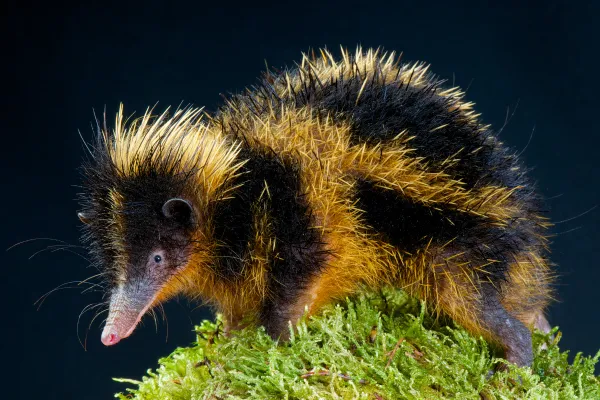
What is a tenrec?
Key characteristics
Types of tenrecs
Where do tenrecs live?
What do tenrecs eat?
How do tenrecs reproduce?
Threats to tenrecs
Fun facts about tenrecs
The term tenrec refers to mammals in the family Tenrecidae, found predominantly on the island of Madagascar.
Although many species look like hedgehogs, shrews, opossums or rats, tenrecs are not closely related to those groups—their evolutionary lineage is very ancient and distinct. Within Madagascar they underwent remarkable diversification, occupying a wide range of habitats and adopting very different ways of life. Their evolution, isolation and variety make them a textbook example of adaptive radiation.
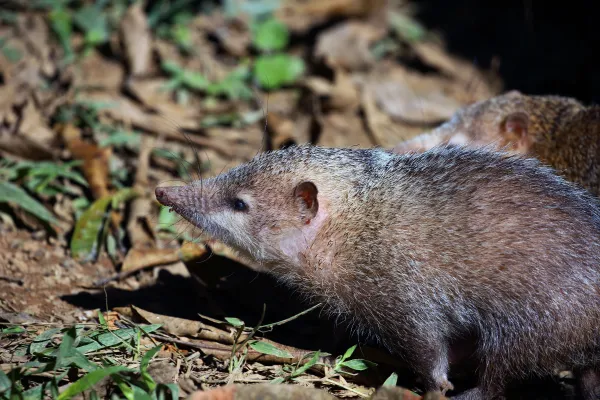
Most species are small-bodied (some only a few centimeters long and weighing just a few grams), though a few are larger. For example, the tailless tenrec (Tenrec ecaudatus) reaches about 26–39 cm in length and up to 2 kg.
Typical features include a slightly elongated snout, small eyes, sensitive vibrissae (whiskers) and, in some species, stiff hairs, spines or barbs.
Anatomically, tenrecs show traits that are rare among placental mammals: in some species the rectum and urogenital tract open into a single cloaca-like orifice.
Dentition varies widely among species, reflecting the family’s diversity.
Physiologically, tenrecs have a lower baseline body temperature than many similar mammals and, in some cases, can enter torpor or short-term hibernation.
The family Tenrecidae comprises multiple genera and species with strikingly different forms. Three commonly recognized subfamilies are Tenrecinae, Oryzorictinae and Geogalinae. For example:
Tenrecinae (hedgehog-tenrecs): genera such as Echinops (lesser hedgehog tenrec) and Setifer (greater hedgehog tenrec).
Oryzorictinae: includes Microgale (many shrew-like species) and Oryzorictes (rice tenrecs, which are burrowers).
Geogalinae: the single genus Geogale, with one species, the large-eared tenrec (Geogale aurita).
In total, at least 30 living species are recognized. Life modes vary widely—some species are semi-aquatic, others terrestrial or fossorial—highlighting the group’s exceptional diversity.
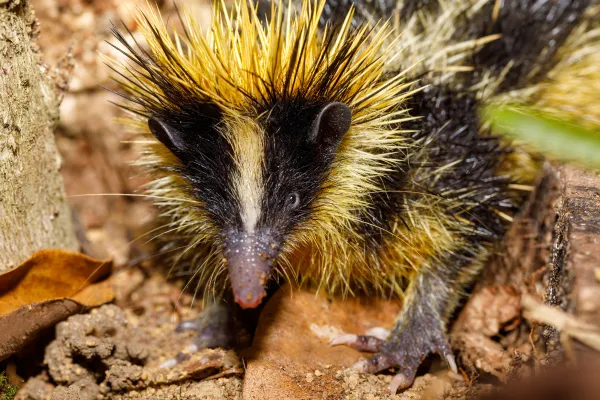
Tenrecs are mostly endemic to Madagascar, meaning they occur naturally only on the island (and, in a few cases, nearby areas). Depending on the species, they occupy rainforests, humid forests, dry forests, savannas, shrublands and even semi-desert zones.
Some species live on the ground under leaf litter or in burrows; others are semi-aquatic, using streams and wetlands as refuge. For example, the lowland streaked tenrec (Hemicentetes semispinosus) inhabits low-elevation tropical forest in northern and eastern Madagascar from sea level up to ~1,550 m.
Most tenrecs are insectivorous, feeding on earthworms, insects and their larvae. Some species also take small vertebrates (amphibians, reptiles or even mice) and plant matter such as fruits.
In semi-aquatic or highly specialized species, the diet can include aquatic animals like aquatic insect larvae or small fish. Typical foraging behavior involves using the elongated snout to probe leaf litter or moist soil, relying on highly sensitive whiskers; several species are nocturnal, taking advantage of darkness to ambush elusive prey.
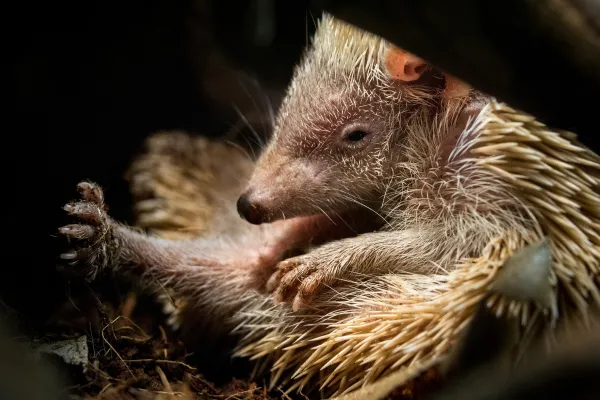
Tenrec reproduction is distinctive. Gestation lasts about 50–70 days. Litters usually number 4–7 young, but the tailless tenrec has recorded litters of 20–30—extraordinary for a mammal of this kind.
Some species have been bred in captivity, though not all reproduce readily outside their natural habitat. Mothers care for the young for a period, and many species exhibit rapid juvenile growth.
While many tenrec species are not currently listed as critically endangered, several face significant risks. The chief threats include habitat loss due to deforestation, logging, forest degradation, and land overuse for agriculture and mining. Local hunting (in some areas tenrecs are eaten) and bycatch also affect certain species. Finally, climate change and the combined effects of multiple pressures may worsen the status of already vulnerable species.
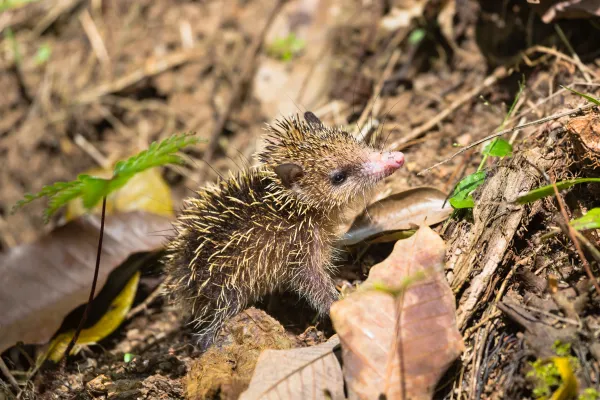
Despite their hedgehog-like look, tenrecs are more closely related to Elephants-Are-Endangered.html">elephants and other members of the Afrotheria clade than to true hedgehogs.
The streaked tenrecs (Hemicentetes) are among the very few mammals known to use stridulation—they rub specialized spines together to produce sound, much like crickets.
Some species enter torpor or temporary hibernation, which is highly unusual among tropical mammals.
Despite their varied forms, tenrecs likely descend from a single ancestor that reached Madagascar tens of millions of years ago, probably rafting over from mainland Africa on floating vegetation.
If you’d like to read more articles like “Tenrecs: Characteristics, Types, Habitat, Diet and Fun Facts,” we recommend exploring our Wild Animals category.
Eisenberg, J. F., & Gould, E. (1970). The Tenrecs: A study in mammalian behavior and evolution (Smithsonian Contributions to Zoology, No. 27). Washington, DC: Smithsonian Institution Press.
Osterloff, E. (s.f.). The wonderfully weird world of tenrecs. Natural History Museum. https://www.nhm.ac.uk/discover/the-weird-world-of-tenrecs.html
Animal Diversity Web. (s. f.). Tenrecidae (tenrecs). University of Michigan. https://animaldiversity.org/accounts/Tenrecidae/ animaldiversity.org
Everson, K. M., Hildebrandt, K. B. P., Goodman, S. M., & Olson, L. E. (2016). Multiple loci and complete taxonomic sampling resolve the phylogeny and biogeographic history of tenrecs (Mammalia: Tenrecidae) and reveal higher speciation rates in Madagascar’s humid forests. Systematic Biology, 65(5), 890-909. https://academic.oup.com/sysbio/article-abstract/65/5/890/2223622?redirectedFrom=fulltext&login=false&utm_source
Gould, E., & Eisenberg, J. F. (1966). Notes on the biology of the Tenrecidae. Smithsonian Institution. https://repository.si.edu/server/api/core/bitstreams/989d5517-81c5-4257-9305-9371617a7375/content
animal tags: Tenrecs
We created this article in conjunction with AI technology, then made sure it was fact-checked and edited by a Animals Top editor.